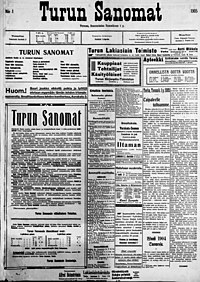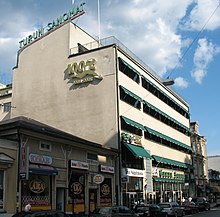Turun Sanomat
 Front page of Turun Sanomat on 1 January 1905 | |
| Type | Daily newspaper |
|---|---|
| Format | Broadsheet |
| Owner(s) | TS-Group |
| Publisher | TS-Yhtymä group |
| Editor | Kari Vainio |
| Founded | 1905 |
| Political alignment | Neutral |
| Headquarters | Turku, Finland |
| Circulation | 50,309 (2018) |
| Website | www |
Turun Sanomat is the leading regional newspaper of the region of Southwest Finland. It is published in the region's capital, Turku and the third most widely read morning newspaper in Finland after Helsingin Sanomat and Aamulehti.
History and profile
[edit]
Turun Sanomat was launched in 1905[1] as supporter of the liberal Young Finnish Party. The founder of the paper was Antti Mikkola, a politician and a journalist.[2] It was subsequently owned and managed by Arvo Ketonen and, following his death in 1948, by his widow Irja Ketonen.[3]
Turun Sanomat was one of the conservative papers in the Cold War period.[4] During this period it was one of the Finnish newspapers which were accused by the Soviet Union of being the instrument of US propaganda, and the Soviet Embassy in Helsinki frequently protested the editors of the paper.[4] The paper has been officially politically independent and non-aligned since 1961. It is owned by TS Group.[5][6] The paper is headquartered in Turku.[7][8] It is published by TS-Yhtymä group[9] in broadsheet format.[10][11]
In 1964, Turun Sanomat began to employ computers and new technology in printing, being a pioneer among European newspapers.[5]
Turun Sanomat publishes two weekly supplements, Treffi (on entertainment, and containing the following week's TV programmes) and Extra, the monthly TS Talous (with in-depth economic coverage), and 24 different TS Teema supplements (lifestyle). It also operates its own printing press and the local television channel Turku TV. The current executive editor of Turun Sanomat is Kari Vainio.
Circulation
[edit]Turun Sanomat was the fourth largest paper in Finland in 1993 selling 119,004 copies.[12] Its circulation was 115,142 copies in 2001, making it the fifth largest paper in the country.[13][14] In 2003, the paper sold 110,000 copies and became the fifth best selling newspaper in the country.[10] The 2004 circulation of the paper was 112,567 copies and it was the third best-selling paper in the country.[15] The same year the paper had a readership of 282,000.[15] In 2005, the paper had a circulation of 111,547 copies.[11] It sold 112,360 copies in 2006.[16] The paper had a circulation of 112,419 copies in 2007.[17]
The circulation of Turun Sanomat was 111,845 copies in 2008 and 109,504 copies in 2009.[18] It was 107,199 copies in 2010 and 103,314 copies in 2011.[18][19] Turun Sanomat was the third most read paper in terms of circulation and sixth largest paper in terms of readership in 2011.[20] The paper sold 99,220 copies in 2012[21] and 97,289 copies in 2013.[22]
References
[edit]- ^ "Turun Sanomat in English". TS Group. Retrieved 10 March 2015.
- ^ "History". Hansaprint. Retrieved 10 March 2015.
- ^ "Tärkeintä on, mitä olemme saaneet aikaan". Turun Sanomat (in Finnish). 2 January 2005. Archived from the original on 1 November 2021. Retrieved 8 January 2021.
- ^ a b Esko Salminen (1998). "The Struggle Over Freedom of Speech in the North The Finnish Press Gave Obeisance to Moscow, but did not Succumb to the Kremlin's Propaganda Programme during the Cold War Years 1968-1991". Scandinavian Journal of History. 23 (3–4): 244. doi:10.1080/03468759850115972.
- ^ a b Nils Enlund; Hans E. Andersin. "The early days of computer aided newspaper production systems" (PDF). DIVA. Retrieved 20 November 2014.
- ^ Mary Kelly; Gianpietro Mazzoleni; Denis McQuail, eds. (31 January 2004). The Media in Europe: The Euromedia Handbook. SAGE Publications. p. 55. ISBN 978-0-7619-4132-3.
- ^ Georgios Terzis, ed. (2007). European Media Governance: National and Regional Dimensions. Intellect Books. p. 99. ISBN 978-1-84150-192-5.
- ^ Tapio Rantala (2011). "Democratic legitimacy of the forest sector and nature conservation decisionmaking in Finnish print media discussion" (PDF). Silva Fennica. 45 (1). doi:10.14214/sf.35.
- ^ "Turun Sanomat chooses Anygraaf's ePlanner". Anygraaf Oy. 2010. Retrieved 7 February 2015.
- ^ a b "World Press Trends" (PDF). World Association of Newspapers. Paris. 2004. Retrieved 8 February 2015.
- ^ a b Kaarina Nikunen (2013). "Losing my profession: Age, experience and expertise in the changing newsrooms" (PDF). Journalism. Sage Publications. doi:10.1177/1464884913508610.
- ^ Bernard A. Cook (2001). Europe Since 1945: An Encyclopedia. Taylor & Francis. p. 384. ISBN 978-0-8153-4057-7.
- ^ "Finland Press and Media". Press Reference. Retrieved 11 November 2014.
- ^ Mary Kelly; Gianpietro Mazzoleni; Denis McQuail, eds. (31 January 2004). The Media in Europe: The Euromedia Handbook. SAGE Publications. p. 62. ISBN 978-0-7619-4132-3.
- ^ a b Olli Nurmi (11 October 2004). "Colour quality control – The Finnish example" (PDF). VTT. Retrieved 19 December 2014.
- ^ "Top ten daily newspapers by circulation 2006". Nordicom. Retrieved 8 March 2015.
- ^ "The Nordic Media Market" (PDF). Nordicom. 2009. Retrieved 7 March 2015.
- ^ a b "National newspapers total circulation". International Federation of Audit Bureaux of Circulations. Retrieved 5 December 2014.
- ^ Katja Lehtisaari; et al. (2012). "Media Convergence and Business Models: Responses of Finnish Daily Newspapers" (Research Report). University of Helsinki. Retrieved 20 December 2014.
- ^ Sanna Koskinen; et al. (2014). "Media portrayal of older people as illustrated in Finnish newspapers". International Journal of Qualitative Studies on Health and Well-being. 9. Retrieved 13 December 2014.
- ^ Sampsa Saikkonen; Paula Häkämies (5 January 2014). "Mapping Digital Media:Finland" (Report). Open Society Foundations. Retrieved 23 April 2015.
- ^ "Circulation Statistics 2013" (PDF). Levikintarkastus Oy - Finnish Audit Bureau of Circulations. 23 June 2014. Retrieved 12 February 2015.
Literature
[edit]- Holmberg, Jukka (January 2004). Etusivun politiikkaa Yhteiskunnallisten toimijoiden representointi suomalaisissa sanomalehtiuutisissa 1987–2003.
